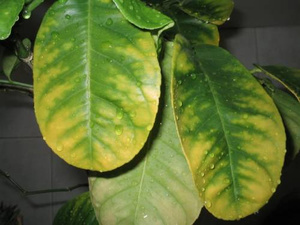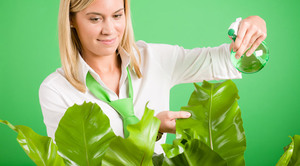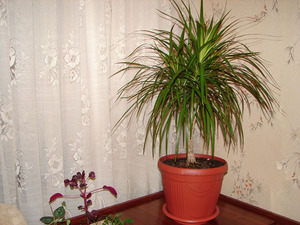Many of us love to surround ourselves with indoor flowers in the house. A summer cottage is also difficult to imagine without vegetation - shrubs, trees, flowers and vegetables. Very often you have to observe how the tips and edges of the leaves begin to turn yellow in many plants for unknown reasons.
Growing plants is not easy and time consuming. It requires certain knowledge and investment of labor and time. Novice growers often face the problem of yellowed leaves.
Why do plants turn yellow? This may be due to improper flower care. In fact, the yellowness of the leaves is for various reasons. We will talk about them in our article.
The main causes and symptoms
 Most often, indoor plants feel uncomfortable in the cold season... Indoors, the air becomes drier, the level of humidity is disturbed. Indoor plants react painfully to this. After the bright sunlight of summer, when it rarely rains, it is difficult for flowers to quickly adapt in conditions with low air humidity. Flowers for various reasons begin to hurt. This manifests itself in the form of yellow spots on the leaves, yellowed edges and tips of the leaves. What is the reason and how to help the "green friends"?
Most often, indoor plants feel uncomfortable in the cold season... Indoors, the air becomes drier, the level of humidity is disturbed. Indoor plants react painfully to this. After the bright sunlight of summer, when it rarely rains, it is difficult for flowers to quickly adapt in conditions with low air humidity. Flowers for various reasons begin to hurt. This manifests itself in the form of yellow spots on the leaves, yellowed edges and tips of the leaves. What is the reason and how to help the "green friends"?
Heat-loving plants always react painfully to cold air and drafts. In the summer, air conditioners operate in many rooms, windows are open for ventilation. In the airing mode, there are often drafts, which is very bad for tropical plants. In this case, it is better to put the flowers aside and protect them from cold air currents.
Almost all plant species cannot be kept in direct sunlight, it is advisable to shade them, otherwise burns in the form of yellow spots will appear on the leaves. Flowers can suffer and from insufficient lighting... This occurs most often on cloudy cold days. If possible, they need to create additional lighting using a phytolamp.
Watering and disease
Very often, flowers can suffer from improper watering. Not all flowers need frequent watering. Excessive moisture only contributes to the development of diseases. There are plant species that need rare watering in the cold season. They have a dormant period in winter and at this time it is better to exclude watering.
Indoor flowers must be sprayed, but this procedure is not suitable for all types of flowers. For this reason, plants often develop yellow spots on the leaves, they turn yellow and dry. Other indoor plants, on the contrary, suffer from insufficient moisture... They need to be watered more often and more abundantly, and if there is not enough moisture, this is manifested by the yellowness of the leaves. Houseplants are recommended to be watered with settled water, but this is often forgotten, watering with cold and chlorinated water, which is very harmful for flowers.
Plants need nutrients and react painfully to their lack. It is necessary to correctly calculate the quantity and proportions for certain types of flowers. For this reason, flowers suffer from chlorosis, their leaves turn yellow due to a lack or excess of nutrients.
Cause of plant diseases there are various pests:
- aphid;
- spider mite;
- whitefly larvae;
- thrips.
The most common fungal diseases affecting plants include the following:
- anthracnose;
- fusarium;
- late blight.
Why do spathiphyllum leaves turn yellow?
 This can happen for a simple reason - the flower has not been transplanted for a long time, it was in the same pot for a long time. When transplanting, you must carefully examine its root. Healthy roots should have creamy white roots; if they are dark brown, they should be removed and only healthy ones should be left. It is advisable to treat a healthy root system before planting in a weak solution of potassium permanganate, and sprinkle the cuts with wood ash.
This can happen for a simple reason - the flower has not been transplanted for a long time, it was in the same pot for a long time. When transplanting, you must carefully examine its root. Healthy roots should have creamy white roots; if they are dark brown, they should be removed and only healthy ones should be left. It is advisable to treat a healthy root system before planting in a weak solution of potassium permanganate, and sprinkle the cuts with wood ash.
During the growing season, the flower needs feeding. For this purpose, a flower complex fertilizer is suitable. Spathiphyllum must be regularly sprayed with water or humidified with a spray bottle, since the plant needs humidified air.
The flower does not like direct sunlight and reacts painfully to them. Burns appear on the leaves in the form of yellow and brown spots.
Yellowness on the leaves can be due to natural causes when the plant is depleted after the flowering period. It is necessary to help him recover, remove old and sick ones. Also, the leaves may fall off for a simple reason - spathiphyllum begins rest period.
Pests often infect the leaves of the plant, these include spider mites and flower thrips. They pierce the vegetation and suck out the juices from there, affecting the tissue of the flower. As a result, yellow spots are formed on the deciduous mass.
Why do dracaena have yellow leaf tips?
 This evergreen tropical plant has become very popular and adorns the interior of many homes. One of the problems in leaving is the yellowness of the leaves. According to experts, the plant needs to follow the rules of cultivation. With poor care, its dark emerald leaves begin to turn yellow, then they turn brown or black.
This evergreen tropical plant has become very popular and adorns the interior of many homes. One of the problems in leaving is the yellowness of the leaves. According to experts, the plant needs to follow the rules of cultivation. With poor care, its dark emerald leaves begin to turn yellow, then they turn brown or black.
Dry leaf tips can be caused by natural aging of the dracaena deciduous mass, due to climatic conditions. Her leaves are on average live 1.5-2 years, after which they turn yellow, dry and disappear completely. The process of foliage withering begins from the top. The lower leaves are more resistant, they die off more slowly. It is very important to create comfortable conditions for the development of the dracaena and then it will delight with its beautiful foliage for a very long time.
She does not like an excess of moisture, she needs good lighting and the correct temperature regime. The plant reacts poorly to bright light, prefers diffused lighting. For this reason, the leaves often begin to turn yellow in dracaena, so you should pay attention to sufficient lighting. In winter, she needs to create artificial lighting with a special lamp. Spots can also appear from direct sunlight, the plant does not like the scorching sun.
The optimum temperature for dracaena is 18-25aboutFROM, it does not tolerate heat or cold. Under such conditions, the plant begins to hurt and soon dies. It is better not to put dracaena on the windowsill during the heating season.
Dracaena develops well at a humidity exceeding 60%. It must be sprayed more often from a spray bottle with warm and settled water. Dry air has a detrimental effect on dracaena, so it is useful for her to arrange a warm shower.
Dracaena loves moderate moisture and reacts poorly to abundant watering. In summer, it needs to be watered once a week, and in winter 2 times a month. It is advisable to loosen the top soil layer in the pot to improve aeration.
The plant loves nitrogenous fertilizers, so it periodic feeding is necessaryespecially on cloudy and cold days. You should also apply special complex fertilizers, because due to their shortage, the tips of the leaves will turn yellow. Periodically, the dracaena needs to be transplanted into a new "house", changing the substrate. If properly cared for, the deciduous mass will be abundant, have a rich green color. Old potting soil can hinder nutrient intake as salts build up over time.A transplant must be done every two years and preferably in the spring.
Caring and proper care will help solve many problems with indoor flowers. It is advisable to constantly monitor the condition of domestic plants and provide them with assistance in time, then they will radiate health and natural beauty.


